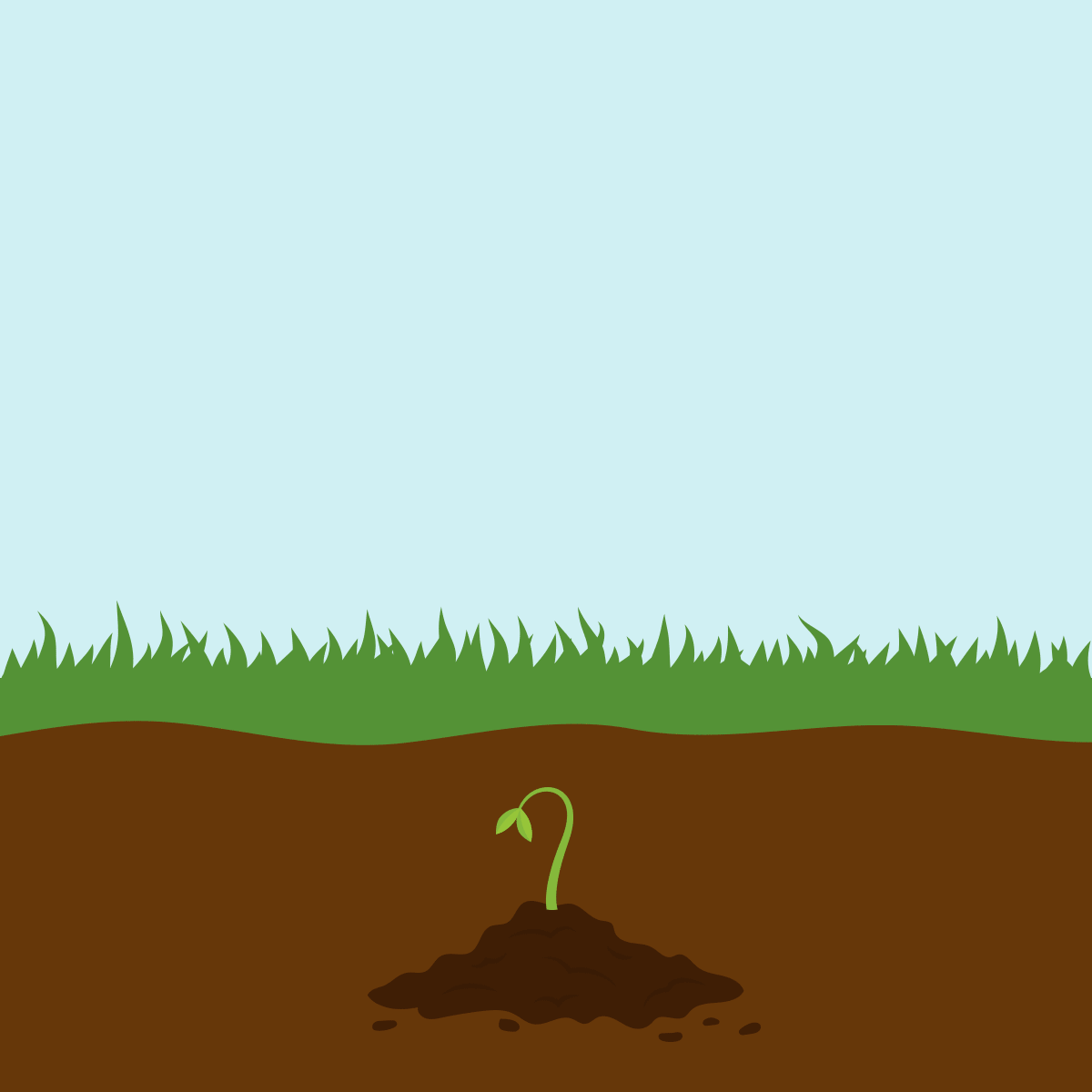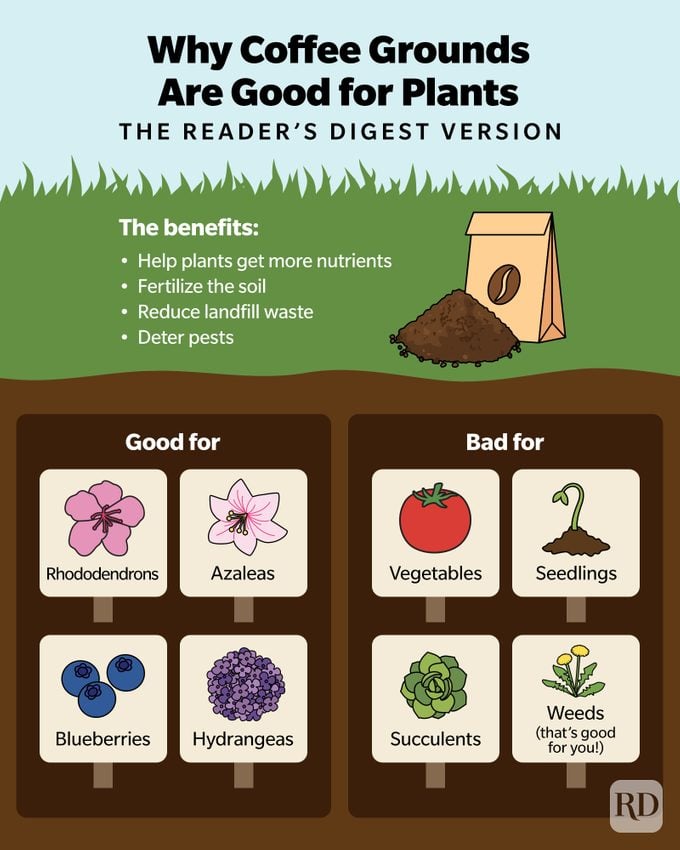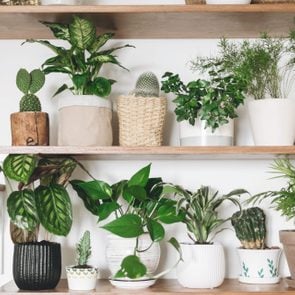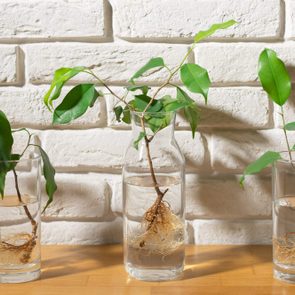How to Use Coffee Grounds to Make Your Plants Thrive
Updated: Jun. 23, 2024

Your guide to the do's and don'ts of using coffee grounds for growing healthier plants
If you’ve been trying to tackle houseplant pests organically and want to learn how to compost, you might want to dig into the idea of recycling coffee grounds for plants. According to Doug Oster, garden book author and co-host of The Organic Gardener radio show, “It is one of those ingredients—it is easy to get, it breaks down quickly.” And like all living matter, he laughingly adds, it will compost.
Yes, coffee grounds can inject fuel into your garden as well as into your morning routine. Regardless of season and space, you can start to work on those container garden ideas and reduce food waste with the compost bins you were gifted for the holidays. Even indoor plants will perk up with coffee grounds if you follow a few guidelines from cup to compost.

Get Reader’s Digest’s Read Up newsletter for more gardening tips, humor, cleaning, travel, tech and fun facts all week long.
Are coffee grounds good for plants?
You bet! Using coffee grounds for plants improves the soil and reduces landfill waste. Simply tilling used grounds into the soil can help with aeration, drainage and water retention. More important, coffee grounds add vital nitrogen to the soil that allows plants to absorb water and nutrients.
It doesn’t matter if you drink decaf or regular—either will do the trick. As for the format, used ground coffee is the gold standard, though some plants can handle grounds that haven’t been brewed. To improve your mood and the garden, try mastering that perfect cup of coffee and reserving the grounds for later.
As for indoor plants, a teaspoon of spent coffee grounds mixed into the soil of most can work. Super-diluted coffee dregs can even be used for occasional watering. Remember that grounds help with water retention, so skip the succulents and plants that like the soil dry to avoid root rot.
Which plants can I put coffee grounds on?
Both indoor and outdoor plants can benefit from a java boost, but that doesn’t mean you can take a one-size-fits-all approach to coffee in your garden. For best results, use the type of grounds that best suit your plants.
Coffee that has been brewed works best for the garden, says Sonia Uyterhoeven, head of horticulture at New Jersey’s Greenwood Gardens. “When you make coffee, all acidity gets washed out,” she says. That means it won’t change the pH level in your garden. You can blend used grounds into the soil throughout the garden, but she prefers adding it to compost, which is better garden food overall.
Coffee that has been roasted but never brewed is fine for acid-loving plants, including rhododendrons, azaleas, hydrangeas, Pieris, andromeda and camellia. Uyterhoeven suggests sprinkling those grounds in a thin layer around a bed of acid-loving plants, along with a layer of mulch.
For the veggie patch, Oster recommends composted coffee grounds only. Blueberries benefit from an acidic environment to which coffee can contribute. Higher nitrogen would also help spinach, lettuce, arugula and mustard greens.
Which plants do not like coffee grounds?
Not all plants are receptive to soil mixed with used coffee grounds. Take, for instance, your vegetable garden. If you grow your own food and want yours to thrive, you’ll avoid adding coffee grounds by themselves directly to it.
And to those who always ask: Are coffee grounds good for tomato plants? The short answer is no. Oster recommends tomato-specific fertilizers, well-rotted manure or balanced compost. Ditto for bell peppers.
Coffee grounds may also deter seedlings, so skip them in areas where you’ve started plants from seed. Other plants that don’t love the leftovers from your morning brew? Weeds—and that’s a good thing. Experiment in areas where weeds self-sow and thrive. The grounds could be your best-smelling, organic weed deterrent!
How do you use coffee grounds for plants?
If you want to add your coffee grounds directly to plants, remember those rules about acidity. For hydrangeas and azaleas, it’s fine to add a thin layer around the plants themselves. Even a leftover bag of ground coffee that hasn’t been brewed can work. Just try to avoid a solid mass of coffee grounds, since that could block water.
Coffee grounds in compost
Compost needs brown and green materials to work effectively. Despite their appearance, coffee grounds are considered “green”—that is, they add nitrogen. Oster aims for a 50-50 mix of green materials and brown ingredients like newspaper and dry leaves. When he adds coffee grounds, he includes the paper coffee filter (feel free to tear it into smaller pieces) and a layer of straw.
To use compost, wait until it’s completely decomposed (that can take months or years, depending on heat, ingredients, location and other variables). Spread it evenly in beds in early spring or the end of the growing season. For new plantings, combine compost with existing soil.
Coffee grounds as fertilizer
While coffee grounds can change soil acidity and add nitrogen, using them directly as a fertilizer takes time. If the coffee has been brewed, the acidity has been neutralized. Spent grounds can be lightly tilled into the soil or spread around throughout a planting bed. They will take longer to break down and release nitrogen, so add another fertilizer while the coffee degenerates in the soil.
Be smart about where you’re using coffee grounds. Remember, stick to plants and shrubs rather than veggies if you want to avoid dead plants.
Coffee grounds for pest control
No one likes snails and slugs in the garden. And there is certainly no harm in trying to deter them with some used coffee granules. On their own or mixed with mulch, they will smell pretty good for a while.
That said, despite the rumored benefit, horticulturists say coffee grounds are unlikely to attack the pest population already affecting the plants. It’s possible, however, that the grounds would prevent some garden pests from crossing an uncomfortably granular surface to a different area.
Coffee grounds to keep cats away from plants
Folklore also says cats are not fans of how coffee smells. While it is tough to prove scientifically, it is easy to experiment. Consider using decaffeinated coffee or spent grounds with less acidifying risk. Sprinkle them around the plants you want to protect.
But beware, dog owners: Avoid anything caffeinated that may reach your canine friends. Alternative options to keep pets away from the garden include citrus scents.
Coffee grounds to feed worms
Everything is better in moderation, and that goes for worms that love a good cup of joe. Vermicomposters—folks who compost using worms—swear the grounds are a favorite treat. Start with a small amount to see if the worms like it. If you use too much, your vermicompost could become too acidic.
Just how much should you use? Guidelines vary from about 15% of their diet to an eighth of their bedding.
In the ground, compost naturally attracts worms that ostensibly like coffee as well. That’s a good thing, provided coffee is actually good for worms. But a study published in Bioresource Technology suggests a higher mortality risk for earthworms exposed to coffee grounds in multiple composting methods. The same study showed adding cardboard lowered both the risk and chemical exposure, so gauge your own comfort level.
Coffee ground plant mistakes to avoid
Recycling used coffee grounds for plants isn’t complex, but you’ll have a better chance of success if you avoid the following missteps:
- Don’t use fresh coffee grounds (that haven’t been brewed) if your plants are not familiar to you. The brewing neutralizes the acidity in coffee, removing potential harm to plants that don’t like it. And as an economic matter, why waste coffee if you can brew it first and garden with it later?
- Coffee filters heading to compost should be unbleached to keep the fertilizer organic. The smaller the pieces, the faster the decomposition.
- Avoid chemically flavored coffee grounds for plants.
- A solid layer of coffee grounds can hurt the garden more than it helps by preventing water from reaching the roots when you’re watering your plants. Instead, use it in compost or blend it into the soil.
- Compost coffee grounds for a vegetable garden instead of using them directly. Remember, coffee grounds are not good for tomatoes or seedlings.
- Get a soil test, especially if your plants are not thriving or you want to change the acidity of the soil. Most counties have a local Cooperative Extension Service that offers services to gardeners.
Sources:
- Doug Oster, co-host of The Organic Gardener radio show and author of The Steel City Garden
- Sonia Uyterhoeven, head of horticulture at Greenwood Gardens
- University of Missouri: “Nitrogen in the Plant”
- Bioresource Technology: “Evaluation of three composting systems for the management of spent coffee grounds”
- Trees.com: “Coffee Grounds for Gardening – Pros, Cons, and How to Use Them”






















